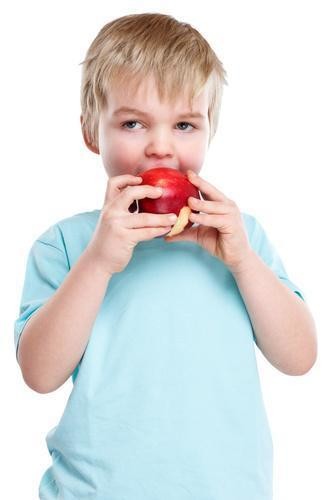Family & children
Learning together and having fun with healthy choices.
Healthy nutrition for the whole family
As parents, you only want the best for your family, especially when it comes to health. Between home, work and family commitments, time is often limited. But you still want to be a role model for your children, and help them have the best start in life possible – without neglecting your own needs. This is easier said than done.
It is precisely in these stressful life situations that a balanced nutrition is crucial. It provides energy for everyday life and gives you quality of life to enjoy precious moments with your loved ones.

Do something good for yourself and your family
8 Principles for successfully implementing healthy changes
- Teach your child a healthy diet at an early age so that it becomes an integral and natural part of his or her everyday life.
- Involve the whole family in all the preparation processes – from planning to shopping to cooking and laying the table. This will lighten your workload and give you a beautiful shared family experience.
- As much as possible, sit together as a family at the dinner table to enjoy your meals. Keep it relaxed and don't worry if your kids fidget or get up and down from the table when they're young.
- Be a positive role model and remember that as parents you have an enormous influence on your children’s eating habits.
- Let us inspire you! Metabolic Balance’s individual nutrition plan, for example, gives you many healthy ideas and valuable suggestions.
- Be creative! Cook with colourful vegetables, make dishes that can be enjoyed by all. Choose simple recipes that you can easily change to cater to their tastes and food tolerances.
- Shop locally, seasonally and conscientiously! The seasonal calendar tells you when you can buy fresh and less expensive local products. Go to your local farmer's market and get to know what's available around you.
- Use planning tools to save time, money and stress. It might be a conventional shopping list, weekly menu or a practical app – choose a planning aid that suits you.

Losing weight together with the family - a great route to success
Let’s say that you or your partner want to lose weight – but how can a change in diet be integrated into everyday life if the whole family has to be taken into consideration? You can do this easily with just a few tricks, a little creativity and some good planning.
It’s important to celebrate the family experience so that everyone can enjoy it. Firstly, plan together. This gets everyone involved from the start. Shop together, cook together, and motivate all the family to start regular exercise and activities together.
Consider incorporating intermittent fasting into your routine. This approach, coupled with family meal planning, fosters shared experiences while potentially aiding in weight loss and improving overall health. Also, get some inspiration for healthy food. The Metabolic Balance nutrition plan, for example, provides personalized guidance tailored to individual needs and caters to the tastes of all family members.
You can conjure up a complete meal for young and old by varying a couple of different elements – such as an additional side dish for adults or a slight variation just before serving. You really don't have to always prepare different meals. Just try out our recipe for below! It can be wonderfully combined with your nutrition plan – and it will become the favourite food of all your children in no time at all – Spaghetti Bolognese.

Recipe tip – mince with vegetables
Ingredients for 1 Metabolic Balance serving and 3 more hungry mouths:
- 2 vegetable pieces (e.g. zucchini and capsicum)
- 2 tomatoes
- 1 diced onion
- 1/2 papaya (or other fruit, depending on your plan)
- 500 g minced beef (or other, depending on your plan)
- Salt, pepper
- Caraway
- Organic apple vinegar
- Chives
For the 3 who have no Metabolic Balance nutrition plan:
- 250 g spaghetti (whole grain is best)
Tip for the strict phase – cook the weighed Metabolic Balance portion in a pan without oil, the rest in another pan with some olive oil. In this way, you can correctly adhere to the weight specifications of your nutrition plan.
Preparation:
Wash and clean the fruit and vegetables. Cut the vegetables into pieces, prepare the onion, cut the tomato and capsicum into cubes. Now weigh the ingredients for the Metabolic Balance portion. Bring a pot of water to the boil for the spaghetti. Heat two coated pans without fat, in one fry the minced meat of the Metabolic Balance Plan, and fry the rest in the other pan. Season with salt, pepper and caraway seeds.
Now put the weighed part of the vegetables, 1 tablespoon of onion and a ½ tomato into the Metabolic Balance pan and put the rest into the other pan. Let everything simmer for ten minutes. While it’s all simmering, cook the spaghetti until it’s al dente. Finally, mix in the papaya pieces, let it all simmer and season both variations with a splash of vinegar.
Serve the Metabolic Balance meal with a portion of rye bread. Family members or guests who do not participate in Metabolic Balance will enjoy the mince pan as a delicious Bolognese sauce with the spaghetti.
Tip: Mediterranean herbs such as oregano or basil make the mince pan even more Italian!
How healthily do we feed our children?
Being time poor is a common problem for many families. Balancing work, kids activities and cooking fresh meals is a constant challenge. Working parents have little time to prepare healthy food. The use of supposedly “healthy” children’s food at first appears to be a good solution – but products advertised especially for children are anything but that.
Processed food manufacturers use a multitude of ways to tempt our children to want unhealthy choices. From colourful packaging with favourite cartoon characters to mini-toys, food manufacturers are experts at attracting children to want their products. They will also target the adults with package claims such as “with valuable cereals”, “added vitamins” and “strengthens the bones”.
In reality, they rarely contain what they promise. Most children’s products contain far too much sugar and unhealthy fats – and they are often full of additives and poor quality vitamin supplements.
Kids eating natural fresh food is so much healthier: a fresh apple in your child’s school box is much better than a finished product in sparkly packaging!

The hurdles in everyday life
Another hurdle is catering in day care centres. Almost two million children eat lunch in day care centres. They often have good intentions but these menus mainly consist of processed foods with too little fruit, vegetables, salad and fresh produce. Some day care centres also prefer hot meals – so the food is delivered, portioned and handed out on site. With this catering system, valuable vital substances are lost during preparation, transport and long periods of warming. Very often the amount of energy per child is too high, but has only minimal nutrient quality. So these meals rarely match the recommendations of the nutrition guidelines.

The best for your child – the essentials for healthy development
The foundation for a healthy life is formed as early as babyhood and the toddling stage. Nutrition influences both the development and the performance of your child.
The question is, do parents have any chance of providing their children with the best possible nutritional care today?
Silvia Bürkle, Nutritionist and one of our founders encourages concerned parents. If you keep certain important essentials in mind, nothing will stand in the way of the healthy development of your child from a nutritional point of view:
- Make sure that fruit, vegetables, milk, whole grain products, fish and high-quality meat are regularly on the menu.
- Familiarise your children with the taste of fresh fruit and vegetables as early as the baby food stage.
- Cook dishes with fresh ingredients and do avoid as much as possible those with artificial additives and preservatives.
- Don’t choose processed “children’s” food and read all product labels carefully.
- Encourage them to eat three meals a day instead of getting into the habit of grazing.
- Make sure that the daily snacks don’t exceed the amount that can fit in a child’s hand.
- Healthy drinks (water, herbal tea) should be available for the children at all times – e.g. in the water cooler or chilled bottles in the fridge or on the counter.
- Encourage your child to enjoy plain water as soon as they are able to hold a cup or drink from a bottle. Avoid high sugar cordials whenever possible.
- Give your child healthy snacks (e.g. apples, carrots, cucumber chunks) for nursery school, kindergarten and primary school.

Cooking together - fun for young and old
Shopping and cooking together can be fun. Cooking at home means meals will be healthier and you can all learn together too for how to create healthy food.
From school age on, children should be eating more or less whatever is put on the table. However, it is not always easy to satisfy all their tastes and involve every family member equally. By planning the weekly meals together, it's easier to agree on compromises and make sure everyone is happy and satisfied.

How to make shopping and cooking an enjoyable family experience:
- Allow each family member to request a dish (his or her own favourite) once a week.
- When shopping and cooking together, everyone contributes by taking on certain tasks.
- Allow your child his or her own drawer or cupboard compartment in the kitchen with his or her personal kitchen utensils.
- Create a fun atmosphere in the kitchen, e.g. with little games like “I spy with my little eye, something beginning with ...”
- Plan an special Sunday brunch once a month – with more choices on the menu and plenty of time for each other.
- Talk about the day's events during cooking and eating, discuss funny moments, plans for the coming days or your next family outing. This way the focus is on the shared experience.
- If older children want to prepare a meal on their own, allow them to do so. Stay in the background for questions and problems and be encouraging of their efforts.
- Share the tidying up too! Maybe try a weekly roster so that everyone gets a night off from the washing up!
Tip: Now make it colourful!
Children love colours. Introduce your children to healthy food and how good it can taste with colourful, varied real foods. Pink strawberry milk, freshly-squeezed orange juice, or a colourful fruit and vegetable plate are great ideas – and they can also be prepared by little chefs with a little help!
Stay safe in the kitchen
Simple recipes such as scrambled eggs, fruit salad or carrot cupcakes are particularly suitable for cooking with children. With more complicated dishes, you simply distribute easy tasks to the little ones, such as cutting vegetables.
Many kitchenware shops sell knives suitable for children. However, the topic of safety is always of primary importance. While the food is being prepared, explain the kitchen rules to prevent accidents:
- Never touch the hot stove.
- Always cut with the blade moving away from the body.
- Chopping boards may not move.
- Never try to catch a falling knife.
- Never extinguish burning fat in the pan with water – stifle the flame with a fire blanket.
- No running and rushing about in the kitchen.
Shopping in accordance with your plan
Shopping, cooking, cleaning, washing – there is a multitude of tasks involved in holding down a job and taking care of a family – every single day. Good organisation saves time and money and will accompany you safely through your week. Here are a few tips for making things work a little easier.
Shopping and meal plan
A weekly meal plan and shopping list helps you to organised and remember everything in a more relaxed way. It helps you make sure that you don’t forget anything important and avoids unnecessary expenses due to spontaneous purchases. With a shopping plan, you can safely schedule your shopping for one day a week. Hang a whiteboard or notice block in a highly visible location and write down anything you need when you think of it. Then when it's time to write your list you can easily make sure you don't forget anything.
It is also worth preparing a meal plan for the whole week – you can decide your breakfast, lunch and dinner choices, including healthy desserts. Then include all the ingredients you'll need on your shopping list.

Regional, seasonal and conscientious
The seasonal calendar is another great shopping aid that tells you which fruit and vegetables are in season. The local products are harvested when genuinely ripe – they are also fresher, richer in nutrients and simply taste better. After all, the hasn't had a long journey in a plane or truck. It's also so much better for the environment too!
Check out the quality yourself at the weekly market, or in a farm or orchard shop. Buy local fruit and vegetables at the supermarket. When buying other foods always read the labels carefully.
Eco or organic boxes are also becoming increasingly popular. They are delivered to your doorstep each week – always freshly put together and usually from local suppliers. Often you'll get a recipe idea that you can adapt to suit Metabolic Balance rules
The Metabolic Balance App - a mobile shopping assistant!
Mobile shopping assistants such as our app "Metabolic Balance for you" are particularly practical and always ready to hand.
It’s linked to your personal nutrition plan and food list together with healthy recipe suggestions for your meals.
A clearly-arranged weekly plan presents all the selected dishes. On top of that, the required ingredients are conveniently placed on your personal shopping list. If you haven't already check it out now at your app store.

Does your child drink enough water?
Studies show that many children do not drink enough fluids. Dehydration can quickly lead to both short and long term problems. So what can we do to encourage our little ones to drink enough?
Children need more fluid than adults in proportion to their body size, and if they don’t drink enough, health problems will soon happen: both physical and mental performance is effected such as they suffer from dizziness, irritability, fatigue and headaches.
In the long run, for example, urinary tract disorders and problems with bowel movements can develop – but even one additional 200ml glass of water a day can make a real difference and help balance their hydration levels.
How much fluid does my child need?
| Age | Recommended daily water intake through drinks |
|---|---|
| 4 to 6 years | 940 ml |
| 7 to 9 years | 970 ml |
| 10 to 12 years | 1170 ml |
| 13 to 14 years | 1330 ml |
| 15 to 18 years | 1530 ml |
Source: German Nutrition Society
What can I do to ensure that my child drinks enough?
Granted, it’s not easy to persuade children to drink enough regularly – they often don’t even think about drinking because they are distracted or busy, or perhaps they’re not really thirsty, or they simply don’t have a drink with them.
Tips:
- Don’t wait for your child to get thirsty. Thirst is an early sign of dehydration. It's much better to drink regularly several times a day.
- Please remember the hydration needs of your child can increase significantly during sports, being outside, during hot weather and during illness.
- Water is simply the best drink. It contains no calories and no sugar. You can also give a child unsweetened fruity and herbal teas. Iced herbal teas are a great alternative to soft drinks and cordials.
- Offer your child additional naturally hydrating foods, such as water-rich fruit, vegetables and soup.
- Put a light drinking bottle with water in your child’s schoolbag.
- In school, children should be allowed to drink at any time during a lesson.

